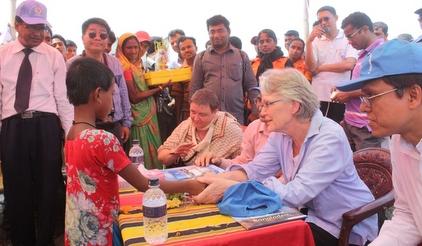UNISDR Chief visits Bangladesh cyclone belt
Margareta Wahlström, UNISDR Chief and Special Representative of the Secretary-General for Disaster Risk Reduction, shakes the hand of a child in Bainpara, Bangladesh By Brigitte Leoni
BANGKOK, 2 April 2012 - A visit to a disaster-resilient habitat in Bangladesh has prompted UNISDR Chief Margareta Wahlström to acknowledge the south Asian country as leading developing nations in the global fight against climate change impacts.
On the final day of a three day visit, she went Friday to the village of Bainpara, Dacope, in Khulna Division on Bangladesh's south-west coast where she saw what she called "a small but excellent example of a disaster risk reduction and climate change adaptation programme with clear development benefits."
Currently, 290 people from Bainpara are benefitting from the project. Fifty-eight families have each received 240 square metres of land, along with a cyclone-resistant house which can withstand winds of up to 215 KM/hr. The homes stand on plinths raised five feet above the highest recorded flood level and are equipped with water and sanitation facilities, solar panels and improved stoves.
The project also includes other protection measures to strengthen community resilience. These include a secondary flood defense embankment, community ponds with water treatment plants, a cyclone-resistant school, a community information centre and a community health centre which will provide clean water to families after storms and allow children to continue with schooling and to receive care when cyclones hit.
The project also provides the community with boats, and skills training so people can learn other jobs that can protect incomes when disasters occur.
"This is helping people to cope with natural hazards and to continue rebuilding their lives and livelihood. We encourage countries and communities to replicate the Bainpara project and continue investing in DRR measures as we will be affected by more severe and possible more frequent cyclones and storms in the future," said Wahlström.
The pilot project, implemented by the Comprehensive Disaster Management Programme (CDMP) and the Disaster Management and Relief Division of the Ministry of Food and Disaster Management with technical assistance from the UN Development Programme (UNDP), was put in place just after cyclone Aila washed away most of the houses of the village in May 2009 killing 330 people and affecting more than 500,000 people in the country.
Wahlström said: "This disaster resilient habitat is a great concept which combines sustainable DRR solutions such as the construction of embankments and cyclone shelters, together with comprehensive preparedness and prevention measures including community-based cyclone early warning and ecosystem management.
Just a day before her visit to Bainpara, Wahlström attended the Bangladesh National Disaster Preparedness Day in Dahka and stressed that, "Disaster preparedness and disaster risk reduction are indeed the best investments that nations can make today to protect their development gains against disasters; Bangladesh is the proof of it".
The UNISDR head also met with Dr. Muhammad Abdur Razzaque, Minister of Food and Disaster Management in Dahka, and other government officials, and stressed the importance of investing in DRR policies to better cope with climate related disasters.
BANGKOK, 2 April 2012 - A visit to a disaster-resilient habitat in Bangladesh has prompted UNISDR Chief Margareta Wahlström to acknowledge the south Asian country as leading developing nations in the global fight against climate change impacts.
On the final day of a three day visit, she went Friday to the village of Bainpara, Dacope, in Khulna Division on Bangladesh's south-west coast where she saw what she called "a small but excellent example of a disaster risk reduction and climate change adaptation programme with clear development benefits."
Currently, 290 people from Bainpara are benefitting from the project. Fifty-eight families have each received 240 square metres of land, along with a cyclone-resistant house which can withstand winds of up to 215 KM/hr. The homes stand on plinths raised five feet above the highest recorded flood level and are equipped with water and sanitation facilities, solar panels and improved stoves.
The project also includes other protection measures to strengthen community resilience. These include a secondary flood defense embankment, community ponds with water treatment plants, a cyclone-resistant school, a community information centre and a community health centre which will provide clean water to families after storms and allow children to continue with schooling and to receive care when cyclones hit.
The project also provides the community with boats, and skills training so people can learn other jobs that can protect incomes when disasters occur.
"This is helping people to cope with natural hazards and to continue rebuilding their lives and livelihood. We encourage countries and communities to replicate the Bainpara project and continue investing in DRR measures as we will be affected by more severe and possible more frequent cyclones and storms in the future," said Wahlström.
The pilot project, implemented by the Comprehensive Disaster Management Programme (CDMP) and the Disaster Management and Relief Division of the Ministry of Food and Disaster Management with technical assistance from the UN Development Programme (UNDP), was put in place just after cyclone Aila washed away most of the houses of the village in May 2009 killing 330 people and affecting more than 500,000 people in the country.
Wahlström said: "This disaster resilient habitat is a great concept which combines sustainable DRR solutions such as the construction of embankments and cyclone shelters, together with comprehensive preparedness and prevention measures including community-based cyclone early warning and ecosystem management.
Just a day before her visit to Bainpara, Wahlström attended the Bangladesh National Disaster Preparedness Day in Dahka and stressed that, "Disaster preparedness and disaster risk reduction are indeed the best investments that nations can make today to protect their development gains against disasters; Bangladesh is the proof of it".
The UNISDR head also met with Dr. Muhammad Abdur Razzaque, Minister of Food and Disaster Management in Dahka, and other government officials, and stressed the importance of investing in DRR policies to better cope with climate related disasters.

No comments:
Post a Comment